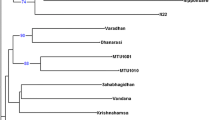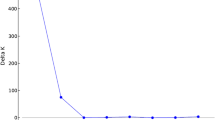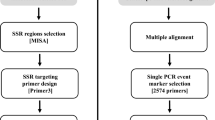Abstract.
Four multiplex panels of fluorescent-labeled rice microsatellite markers were designed to survey allelic diversity at a total of 27 simple sequence repeat loci. Automated fragment detection, size calling and binning were used to identify the microsatellite alleles. The panels were tested on 72 accessions representing the diversity of ecotypes and isozyme groups in cultivated rice (Oryza sativa L.). Genetic diversity was evaluated by estimating the distribution and range of allele sizes, as well as the polymorphism information content (PIC), for each microsatellite locus. The multiplex panels were shown to be useful for fingerprinting and for clustering rice varieties, and genetic associations determined in this analysis agreed well with previous isozyme- and RFLP-based studies of these genotypes. Because of the wide cross-section of germplasm represented, we expect that the allele size-ranges reported here are close to the maximum for cultivated rice. In the future, panels of microsatellites from each rice chromosome will be made to facilitate the mapping of segregating populations and the identification of genes and QTLs underlying traits of interest.
Similar content being viewed by others
Author information
Authors and Affiliations
Additional information
Electronic Publication
Rights and permissions
About this article
Cite this article
Blair, M.W., Hedetale, V. & McCouch, S.R. Fluorescent-labeled microsatellite panels useful for detecting allelic diversity in cultivated rice (Oryza sativa L.). Theor Appl Genet 105, 449–457 (2002). https://doi.org/10.1007/s00122-002-0921-5
Received:
Accepted:
Issue Date:
DOI: https://doi.org/10.1007/s00122-002-0921-5




